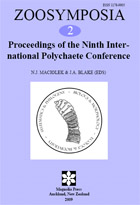Issue:
Vol. 2: 31 August 2009
Type: Article
Published: 2009-08-31
Page range: 241–264
Abstract views: 985
PDF downloaded: 1103
Phylogeny of Eunicida (Annelida) based on morphology of jaws
Department of Biological Sciences, Macquarie University, Sydney, NSW 2109, Australia
maxillae
mandibles
ontogeny
ctenognath
placognath
labidognath
prionognath
symmetrognath
fossils
scolecodonts

